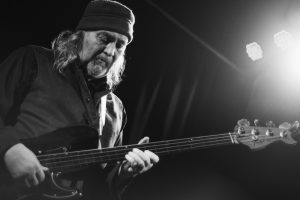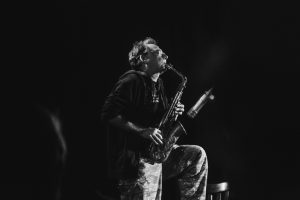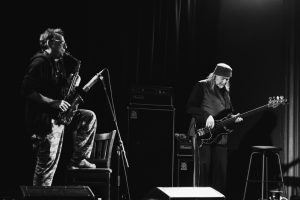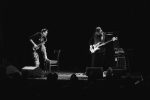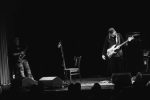REVIEW: John Zorn and Bill Laswell explore experimentation at migrant reunification benefit at the Chapel

Photos: Shawn Robbins
SAN FRANCISCO — Watching John Zorn and Bill Laswell on stage at The Chapel in San Francisco Friday, a sentence James Baldwin wrote in his famous short story Sonny’s Blues hung in the air: “The man who creates the music is hearing something else, is dealing with the roar rising from the void and imposing order on it as it hits the air.”
John Zorn and Paul Laswell
9 p.m., Saturday
The Chapel
Tickets: $65; may be available at the door.
The seasoned veterans of the experimental music scene power-washed the audience with sheets of discordant noise at a concert benefiting “Keep Families Together,” a charity for families separated at the U.S.-Mexico border.
These two with weren’t imposing order on the chaos, they were allowing fans to gaze directly into the abyss.
The collaboration between the two musical giants—who between the two of them have produced and performed on close to 1000 albums and collaborated with musicians as diverse as David Byrne, Iggy Pop, Mike Patton, Herbie Hancock and others—was a West Coast first. The two musicians associated with the New York City music scene they both immigrated to in the mid-1970s took the stage Friday night for the first of two charity shows in a series put on by The Chapel. The second night is tonight.
John Zorn and Bill Laswell, both now in their 60s, emerged on the small stage without a word. Zorn, wearing glasses, duck camo jogging pants, and a black hoodie, looked like a college professor on his day off. He stood on the side of the stage as Laswell, clad in a gray sweatshirt, black Adidas sweatpants with red, green and yellow stripes, and looking vaguely like a chess hustler from Washington Square Park, coaxed smooth mournful phrases from his fretless Fender bass. Soon, Zorn joined Laswell at center stage, and after putting his foot up on a wooden chair began to wail along.
John Zorn’s performance overflowed with musicianship as he coaxed previously unheard sounds from his saxophone: bubbling water pipe sounds and smacking kissing noises, discordant skronks that filled the room. Zorn demonstrated incredible circular breathing, belting out a single undying note on his horn for what seemed like an eternity while fans’ excitement grew with each passing second. At other times, Zorn would place the bell of his horn against his thigh, producing a strange muted vibrato effect, or he’d take his horn apart and play just the mouthpiece. All the while Laswell laid down a solid foundation that was both rhythmic and lyrical.
The music was hypnotic. The saxophone and bass chased each other through forests of notes, only to relax occasionally and luxuriate in a field of harmony. The sounds were in turn, melodic and soothing, plaintive and discordant cries, or the excavation of a single note that they would pick and probe at like sonic prospectors. Laswell’s bass alternated between smooth jazzy strolls, synthy stabs, and distorted walls of low end.
Though the theater was full and the audience enthusiastic, the sonic sorcery wasn’t for everyone. But Laswell and Zorn held those tuned to their frequency completely entranced.
After about 45 minutes, the music ceased and the pair stood triumphant on the stage while the audience gave them a standing ovation. When they emerged again five minutes later, they launched into a distorted and chaotic explosion of sound that lasted for another 10 minutes.
Experimental music is always dangerous. After all, experiments are designed to either succeed or fail. And if they’re being performed live, onstage, in front of an audience, the possibility of a musical misstep is real. But when the experiments are being performed by some of music’s most credentialed practitioners, the results will be interesting if nothing else.
- John Zorn and Bill Laswell perform at The Chapel in San Francisco on July 13, 2018.
- John Zorn and Bill Laswell perform at The Chapel in San Francisco on July 13, 2018.
- Fans watch John Zorn and Bill Laswell perform at The Chapel in San Francisco on July 13, 2018.
- John Zorn and Bill Laswell perform at The Chapel in San Francisco on July 13, 2018.
- John Zorn and Bill Laswell perform at The Chapel in San Francisco on July 13, 2018.
Follow David Gill at Twitter.com/DavidGi18788752. Follow photographer Shawn Robbins at Instagram.com/photo_robbins and Twitter.com/shawnTHErobbins.

